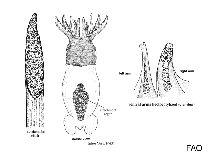Idiosepius kijimuna Reid, Sato, Jolly & Strugnell, 2023
Ryukyu pygmy squidGoogle image | No image available for this species;
drawing shows typical species in Idiosepiidae.
Classification / Names Κοινά ονόματα | Συνώνυμα | CoL | ITIS | WoRMS
Cephalopoda | Sepiolida | Idiosepiidae
Environment: milieu / climate zone / εύρος βάθους / distribution range Οικολογία
βενθικό(ς); εύρος βάθους 2 - ? m (Αναφ. 129526). Subtropical
Distribution Χώρες | Περιοχές FAO | Οικοσυστήματα | Παρουσίες | Εισαγωγές
Northwest Pacific: Japan.
Length at first maturity / Μέγεθος / Weight / Age
Γεννητική Ωρίμανση: Lm ? range ? - ? cm Max length : 0.8 cm ML αρσενικό/απροσδιόριστο; (Αναφ. 129526); 1.18 cm ML (female)
Life cycle and mating behavior Γεννητική Ωρίμανση | Αναπαραγωγή | Γεννοβολία | Eggs | Γονιμότητα | Larvae
Main reference
Αναφορές | Συντονιστής | Συνεργάτες
Reid, A., N. Sato, J. Jolly and J. Strugnell 2023 Two new pygmy squids, Idiosepius kijimuna n. sp. and Kodama jujutsu n. gen., n. sp. (Cephalopoda: Idiosepiidae) from the Ryukyu Islands, Japan. Mar. Biol. 170:167. (Αναφ. 129526)
IUCN Red List Status
(Αναφ. 130435: Version 2025-1)
CITES status (Αναφ. 108899)
CMS (Αναφ. 116361)
Threat to humans
Human uses
| FishSource |
Εργαλεία
Περισσότερες πληροφορίες
Σύσταση δίαιτας
Κατανάλωση τροφής
Θηρευτές
Max. ages / sizes
Length-weight rel.
Length-length rel.
Length-frequencies
Mass conversion
Αφθονία
Γεννητική Ωρίμανση
Γονιμότητα
Γεννοβολία
Eggs
Egg development
Larvae
Διαδικτυακές πηγές
BHL | BOLD Systems | CISTI | DiscoverLife | FAO(Publication : search) | Fishipedia | GenBank (genome, nucleotide) | GloBI | Gomexsi | Google Books | Google Scholar | Google | PubMed | Δέντρο Ζωής | Wikipedia (Go, αναζήτηση) | Zoological Record



